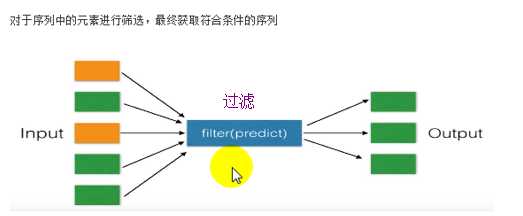标签:
def f1():
return 123
f2 = lambda : 123
def f3 = (a1,a2):
return a1+a2
f4 = lambda a1,a2 : a1+a2

1、 abs()取绝对值
all()所有,需要给我传一个可以迭代的东西,给我的所有的值都为真,返回True
any()只要有一个为真就是真
ascii(对象)去对象的类中,找__repr__方法获取其返回值

ascii的执行过程:ascii对象找到类,找到def函数,使用__repr__方法,最后返回一个hello
2、 bin()#二进制 r = bin(11)十进制转二进制
oct()#八进制
int()#十进制
hex()#十六进制
进制转换:
i = int("0b11",base=2)#二进制转换十进制
i = int("11",base=8)#八进制转换成十进制
.......
3、bool,判断真假,把一个对象转换成布尔值:
4、 bytes 字节
bytearray 字节列表(元素是字节)
字节、字符串转换
bytes("xxxx",encoding="utf-8")
5、chr():c = chr(65) print(c)>>>A;c = chr(66) print(c)>>>B
ord():i = ord("t") print(i)>>>116
#一个字节=8位,共256种可能
随机验证码:
#生成一个随机数,65-91
#数字转换成字母,chr(数字)(数字是随机生成的,所有这个生成的字母也是随机的)
#
import random#导入随机数的模块
temp = ""#temp等于一个空的字符串
for i in range(6):
num = random.randrange(0,10)#随机数0-9
if num == 3 or num ==6:#如果系统产生的随机数是3或者是6则执行if(产生数字),如果不是则执行else产生字母
rad2 = random.randrange(0,10)#rad2是数字类型
temp = temp + str(rad2)
else:
rad1 = random.randrange(65, 91) # 生成65到90的随机的数字
c1 = chr(rad1) # 将rad1生成的随机数字转换成一个随机的字母
temp = temp + c1
print(temp)
6、callable()#是否可以被执行
7、divmod()#
r = divmod(10, 3) print(r) >>>(3, 1)3余1
8、enumerate参数为可遍历的变量,如字符串,列表等,返回值为enumerate类
函数用于遍历序列中的元素以及他们的下标
例1:
for i,j in enumerate((‘a‘,‘b‘,‘c‘)): print(i,j)
结果
0 a 1 b 2 c
例2:
for i,j in enumerate({‘a‘:1,‘b‘:2}):
print(i,j)
结果:
0 a 1 b
注:字典在遍历的时候,循环的是keys,然后通过enumerate方法给每一个key加索引,
9、eval():将字符串当成有效表达式来求值并返回计算结果
ret = eval(" a + 60",{"a" : 99})
print()
>>>159
exec("for i in range(10):print(i)")#执行py代码没有返回值
>>>0
1
2
3
.
.
.
9
10、filter(函数,可以迭代的对象)(过滤)
循环可以迭代的对象,获取每一个参数,并让其执行函数

def f1(x):
if x > 22:
return Ture
else:
return False
ret = filter(f1, [11,22,33,225])
for i in ret:
print(i)
>>>33
225
def f1(x):
return x > 22
ret = filter(lambda x: x > 22, [11,22,33,225])
for i in ret:
print(i)
>>>33
225
map(函数,可以迭代的对象)
def f1(x):
return x + 100
ret = map(f1, [1,2,3,4,5])
print(ret)#直接打印会报错,这里需要用for迭代输出
for i in ret:
print()
>>>101
102
103
104
105
def f1(x):
return x + 100
ret = map(lambda x: x + 100, [1,2,3,4,5])
for i in ret:
print()
11、global()全局变量
local()局部变量
12、isinstance()判断某个对象是否是某个类创建的
li = [11,22] r = isinstance(li, list) print(r) >>True
13、iter()
obj = iter([11,22,33,44])
print(obj)
>>>
<list_iterator object at 0x0000000000B59438>
r1 = next(obj)
print(r1)
>>>11
r2 = next(obj)
print(r2)
>>>22
14、 round()四舍五入
15、slice()
16、sum()求和
r = sum([11,22,33,44]) print(r) >>>110
17zip()
li1 = [11,22,33,44]
li2 = ["a","bb","c","e"]
r = zip(li1,li2)
#print(r)
for i in r:
print(i)
>>>
(11, ‘a‘)
(22, ‘bb‘)
(33, ‘c‘)
(44, ‘e‘)
18、排序
li = [1,211,22,3,4] print(li) >>>[1,211,22,3,4] li.sort() print(li) >>>[1,3,4,22,211]
open(文件名/文件路径,模式,编码)
1、基本的打开方式(字符串的形式打开的文件)当文件中有汉字会报错要加上文件内容的编码
在基本打开方式是可以加encoding="utf-8"

"+"表示可以同时读写摸个文件

r+的形式打开
从头开始读取内容
w的时候是在末尾追加,指针到最后
注意:
读,从零开始读
写:
先读最后追加
主动seek,写从当前的seek指针到的位置开始写入
w+先清空,再写入,你可以读新写入的内容,写了之后指针到最后
从开始往后读
x+文件存在报错
a+打开的同时,将指针移至最后,写的时候也是在最后追加,指针到最后
2、以字节的方式打开 rb
以b方式打开时,读取到的内容是字节类型,写入时也需要提供字节类型
f = open("ha.log","rb",encoding="utf-8")
data = f.read()
f.colse()
print(data)
print(type(data))
只写wb
f = open("ha.log","wb")
#f.write("中国")要求以字节的方式写入,给了一个字符串要进行类型转换
f.write(bytes("中国",encoding = "utf-8"))
f.close
注:(带着b的自己转换不带b,python自己转换)
write写入的时候要是字节
data = read()也是字节
普通方式打开
python内部将010101010==》转换成字符串、通过字符串操作
左边010101 中间是python解释器 程序员
二进制方式打开

f.tell()#获取指针位置
f.seek()#调整指针位置
3.2文件操作

class TextIOWrapper(_TextIOBase): """ Character and line based layer over a BufferedIOBase object, buffer. encoding gives the name of the encoding that the stream will be decoded or encoded with. It defaults to locale.getpreferredencoding(False). errors determines the strictness of encoding and decoding (see help(codecs.Codec) or the documentation for codecs.register) and defaults to "strict". newline controls how line endings are handled. It can be None, ‘‘, ‘\n‘, ‘\r‘, and ‘\r\n‘. It works as follows: * On input, if newline is None, universal newlines mode is enabled. Lines in the input can end in ‘\n‘, ‘\r‘, or ‘\r\n‘, and these are translated into ‘\n‘ before being returned to the caller. If it is ‘‘, universal newline mode is enabled, but line endings are returned to the caller untranslated. If it has any of the other legal values, input lines are only terminated by the given string, and the line ending is returned to the caller untranslated. * On output, if newline is None, any ‘\n‘ characters written are translated to the system default line separator, os.linesep. If newline is ‘‘ or ‘\n‘, no translation takes place. If newline is any of the other legal values, any ‘\n‘ characters written are translated to the given string. If line_buffering is True, a call to flush is implied when a call to write contains a newline character. """ def close(self, *args, **kwargs): # real signature unknown 关闭文件 pass def fileno(self, *args, **kwargs): # real signature unknown 文件描述符 pass def flush(self, *args, **kwargs): # real signature unknown 刷新文件内部缓冲区 pass def isatty(self, *args, **kwargs): # real signature unknown 判断文件是否是同意tty设备 pass def read(self, *args, **kwargs): # real signature unknown 读取指定字节数据 pass def readable(self, *args, **kwargs): # real signature unknown 是否可读 pass def readline(self, *args, **kwargs): # real signature unknown 仅读取一行数据 pass def seek(self, *args, **kwargs): # real signature unknown 指定文件中指针位置 pass def seekable(self, *args, **kwargs): # real signature unknown 指针是否可操作 pass def tell(self, *args, **kwargs): # real signature unknown 获取指针位置 pass def truncate(self, *args, **kwargs): # real signature unknown 截断数据,仅保留指定之前数据 pass def writable(self, *args, **kwargs): # real signature unknown 是否可写 pass def write(self, *args, **kwargs): # real signature unknown 写内容 pass def __getstate__(self, *args, **kwargs): # real signature unknown pass def __init__(self, *args, **kwargs): # real signature unknown pass @staticmethod # known case of __new__ def __new__(*args, **kwargs): # real signature unknown """ Create and return a new object. See help(type) for accurate signature. """ pass def __next__(self, *args, **kwargs): # real signature unknown """ Implement next(self). """ pass def __repr__(self, *args, **kwargs): # real signature unknown """ Return repr(self). """ pass buffer = property(lambda self: object(), lambda self, v: None, lambda self: None) # default closed = property(lambda self: object(), lambda self, v: None, lambda self: None) # default encoding = property(lambda self: object(), lambda self, v: None, lambda self: None) # default errors = property(lambda self: object(), lambda self, v: None, lambda self: None) # default line_buffering = property(lambda self: object(), lambda self, v: None, lambda self: None) # default name = property(lambda self: object(), lambda self, v: None, lambda self: None) # default newlines = property(lambda self: object(), lambda self, v: None, lambda self: None) # default _CHUNK_SIZE = property(lambda self: object(), lambda self, v: None, lambda self: None) # default _finalizing = property(lambda self: object(), lambda self, v: None, lambda self: None) # default 3.x
大小默认为当前的位置,当前文件位置不改变,注意:如果一个指定的大小超过了文件的当前大小,其结果依赖于平台
此方法不会在当前文件工作在只读模式打开。
fileObject.truncate([size])
size--如果可选参数存在,文件被截断(最多)的大小
没有返回值

#!/usr/bin/python # Open a file fo = open("foo.txt", "rw+") print "Name of the file: ", fo.name # Assuming file has following 5 lines # This is 1st line # This is 2nd line # This is 3rd line # This is 4th line # This is 5th line line = fo.readline() print "Read Line: %s" % (line) # Now truncate remaining file. fo.truncate() # Try to read file now line = fo.readline() print "Read Line: %s" % (line) # Close opend file fo.close()
结果:
Name of the file: foo.txt Read Line: This is 1st line Read Line:
a = open("5.log","r+",encoding="utf-8")
a.close() #关闭
a.flush() #强行加入内存
a.read() #读
a.readline() #只读取第一行
a.seek(0) #指针
a.tell() #当前指针位置
a.write() #写
1、代码简便,可以通过管理上下文来解决
with open (文件名,打开方式) as f:
#这个方法,通过with代码执行完毕之后,内部会自动关闭并释放文件资源
2、支持打开两个文件
#关闭文件with
with open("5.log","r") as a:
a.read()
#同事打开两个文件,把a复制到b中,读一行写一行,直到写完
with open("5.log","r",encoding="utf-8") as a,open("6.log","w",encoding="utf-8") as b:
for line in a:
b.write(line)
标签:
原文地址:http://www.cnblogs.com/mosson0816/p/5478259.html